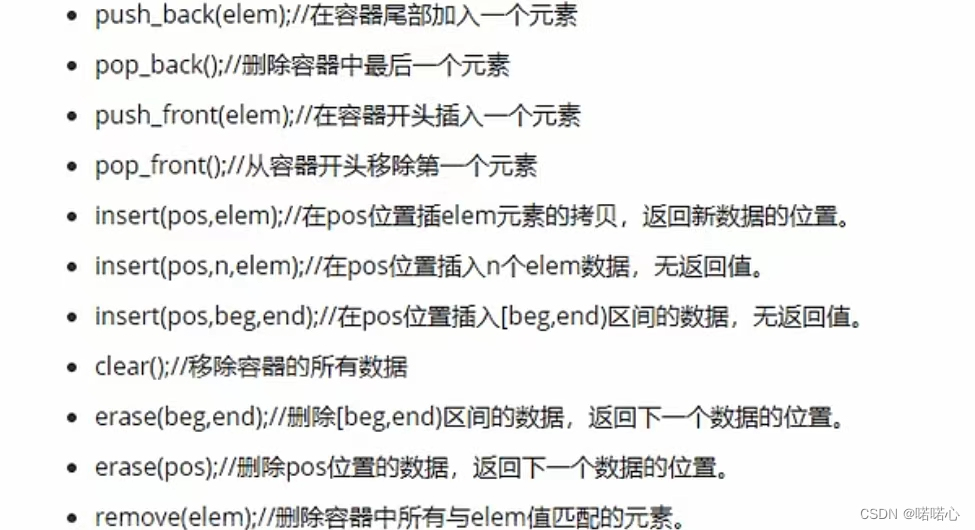c++学习笔记-提高篇-STL标准模板库3(stack容器、queue容器以及list容器)
2023-12-22 14:31:41
目录
stack容器
一、stack容器介绍

二、stack常用接口

三、栈的示例
#include<iostream>
using namespace std;
#include<stack>
//栈stack容器
void test01()
{
//特点:符合先进后出数据结构
stack<int>s;
//入栈
s.push(10);
s.push(20);
s.push(30);
s.push(40);
s.push(50);
cout << "栈的大小为:" << s.size() << endl;
//只要栈不为空,查看栈顶,并执行出栈操作
while(!s.empty())
{
//查看栈顶元素
cout << "栈顶元素为:" << s.top() << endl;
//出栈
s.pop();
}
cout << "栈的大小为:" << s.size() << endl;
}
int main()
{
test01();
system("pause");
return 0;
}queue(队列)容器
一、queue容器介绍

二、queue常用接口

三、queue示例
#include<iostream>
using namespace std;
#include<queue>
class Person
{
public:
Person(string name, int age)
{
this->m_Name = name;
this->m_Age = age;
}
string m_Name;
int m_Age;
};
//队列Queue
void test01()
{
//创建队列
queue<Person>q;
//准备数据
Person p1("唐僧", 30);
Person p2("孙悟空", 1000);
Person p3("猪八戒", 900);
Person p4("沙僧", 800);
q.push(p1);
q.push(p2);
q.push(p3);
q.push(p4);
cout << " 队列的大小:" << q.size() << endl;
//只要队列不为空,查看队头和队尾
while (!q.empty())
{
//查看队头
cout << "队头元素 --- 姓名:" << q.front().m_Name << " 年龄:" << q.front().m_Age << endl;
cout << "队尾元素 --- 姓名:" << q.back().m_Name << " 年龄:" << q.back().m_Age << endl;
//出队
q.pop();
}
cout << " 队列的大小:" << q.size() << endl;
}
int main()
{
test01();
system("pause");
return 0;
}deque(双端队列)是一种可以从两端添加和删除元素的数据结构,而queue(队列)只能从一端添加元素,从另一端删除元素。?
list容器
一、list容器介绍
- 功能:将数据进行链式存储;
- 链表(list)是一种物理存储单元上非连续的存储结构,数据元素的逻辑顺序是通过链表中的指针链实现的;
- 链表的组成:由一系列的节点组成
- 结点的组成:存储数据元素的数据域 + 下一个结点地址的指针域
- STL中的链表是一个双向循环链表
优点:1.可以对任意位置进行快速插入或删除元素,修改指针即可;2.采用动态存储分配,不会造成内存浪费和溢出。
缺点:1.对于容器的遍历速度,没有数组快;2.占用的空间比数组大。

prev指向前一个节点的指针,next指向后一个节点的指针,链表的存储方式并不是连续的内存空间,因此链表list中的迭代器只支持前移和后移,属于双向迭代器
vector和list是两个常用的容器,各有优缺点
二、list常用接口及示例
(一)list构造函数
1.功能描述:创建list容器
2.函数原型:
 ?3.示例
?3.示例
#include<iostream>
using namespace std;
#include<list>
//list容器构造函数
void printList(const list<int>& L) //const防止迭代器被修改
{
for (list<int>::const_iterator it = L.begin(); it != L.end(); it++)//const_iterator只读迭代器
{
cout << *it << " ";//访问指针it所指向的内存地址上的值
}
cout << endl;
}
void test01()
{
//创建list容器
list<int>L1;
//添加数据
L1.push_back(10); //尾插
L1.push_back(20); //尾插
L1.push_back(30); //尾插
L1.push_back(40); //尾插
//遍历容器
printList(L1);
//区间方式构造
list<int>L2(L1.begin(), L1.end());
printList(L2);
//拷贝构造
list<int>L3(L2);
printList(L3);
//10个1000
list<int>L4(10, 1000);
printList(L4);
}
void main()
{
test01();
system("pause");
}(二)list赋值和交换
1.功能描述:给list容器进行赋值,以及交换list容器
2.函数原型:

?3.示例
#include<iostream>
using namespace std;
#include<list>
void printList(const list<int>& L)
{
for (list<int>::const_iterator it = L.begin(); it != L.end(); it++)
{
cout << *it << " ";
}
cout << endl;
}
//list容器的赋值个交换
//赋值
void test01()
{
list<int>L1;
L1.push_back(10);
L1.push_back(20);
L1.push_back(30);
L1.push_back(40);
printList(L1);
list<int>L2;
L2 = L1; //Operator= 赋值
printList(L2);
list<int>L3;
L3.assign(L2.begin(), L2.end());
printList(L3);
list<int>L4;
L4.assign(10, 100);
printList(L4);
}
void test02()
{
list<int> L1;
L1.push_back(10);
L1.push_back(20);
L1.push_back(30);
L1.push_back(40);
list<int>L2;
L2.assign(10, 100);
cout << "交换前:" << endl;
printList(L1);
printList(L2);
L1.swap(L2);
cout << "交换后:" << endl;
printList(L1);
printList(L2);
}
int main()
{
test02();
system("pause");
return 0;
}(三)list大小操作
1.功能描述:对容器的大小进行操作
2.函数原型:
 3.示例
3.示例
#include<iostream>
using namespace std;
#include<list>
//list容器大小操作
void printList(const list<int>& L)
{
for (list<int>::const_iterator it = L.begin(); it != L.end(); it++)
{
cout << *it << " ";
}
cout << endl;
}
void test01()
{
list<int>L1;
L1.push_back(10);
L1.push_back(20);
L1.push_back(30);
L1.push_back(40);
printList(L1);
if (L1.empty())
{
cout << "L1为空" << endl;
}
else
{
cout << "L1不为空" << endl;
cout << "L1的元素个数:" << L1.size() << endl;
}
//重新指定大小
L1.resize(10);
printList(L1);
L1.resize(12, 111);
printList(L1);
L1.resize(2);
printList(L1);
}
int main()
{
test01();
system("pause");
return 0;
}?(四)list插入和删除
1.功能描述:对list容器进行数据的插入和删除
2.函数原型:

pos不要用索引值,要用迭代器
3.示例:
#include<iostream>
using namespace std;
#include<list>
//list容器插入和删除
/*
-push_back(elem);//在容器尾部加入一个元素
-pop_back(elem);//删除容器中最后一个元素
-push_front(elem);//在容器首部加入一个元素
-pop_front(elem);//删除容器开头的一个元素
-insert(pos,elem);//在pos位置处插入elem元素的拷贝,返回新数据的位置
-insert(pos,n,elem);//在pos位置插入n个elem数据,无返回值
-insert(pos,beg,end);//在pos位置插入[beg,end)区间的数据,无返回值
-clear();//移除容器的所有数据
-erase(beg,end);//删除[beg,end)区间的数据,返回下一个数据的位置
-erase(pos);//删除pos位置的数据,,返回下一个数据的位置
-remove(elem);//删除容器中所有与elem值匹配的元素
*/
void printList(const list<int>&L)//const防止迭代器被修改
{
for (list<int>::const_iterator it = L.begin(); it != L.end(); it++)
{
cout << *it << " ";
}
cout << endl;
}
void test01()
{
list<int>L;
//尾插
L.push_back(10);
L.push_back(20);
L.push_back(30);
//头插
L.push_front(100);
L.push_front(200);
L.push_front(300);
//300 200 100 10 20 30
printList(L);
//尾删
L.pop_back();
L.pop_front();
printList(L);
//插入
L.insert(L.begin(), 1000);
printList(L);
list<int>::iterator it = L.begin();
L.insert(++it, 2000);
printList(L);
//删除
it = L.begin();
L.erase(it);
//L.erase(++it);
printList(L);
//移除
L.push_back(10000);
printList(L);
L.remove(10000);
printList(L);
}
int main()
{
test01();
system("pause");
return 0;
}?(五)list数据存取
1.功能描述:对list容器中的数据进行存取
2.函数原型:
- front()? //返回第一个元素
- back()? //返回最后一个元素
3.示例:
#include<iostream>
using namespace std;
#include<list>
//list容器 数据存取
void test01()
{
list<int> L1;
L1.push_back(10);
L1.push_back(20);
L1.push_back(30);
L1.push_back(40);
//L1[0] 不可以用[]访问list容器中的元素
//L1.at(0) 不可以用at的方式来访问list中的元素
//原因是list本质是链表,不是用连续的线性空间存储数据,迭代器不支持随机访问的
cout << "第一个元素" <<L1.front()<< endl;
cout << "最后一个元素" << L1.back() << endl;
//验证迭代器不支持随机访问的
list<int>::iterator it = L1.begin();
it++; //支持递增
it--; //支持递减
//it = it + 1; 不支持随机访问
}
int main()
{
test01();
system("pause");
return 0;
}(六)list反转和排序
1.功能描述:将容器中的元素反转,以及将容器中的数据进行排序
2.函数原型:
- reverse();//反转链表
- sort();//链表排序
3.示例:
list排序时自己有sort()成员函数,默认升序;降序排序时,需要给sort()函数传入回调函数
#include<iostream>
using namespace std;
#include<list>
#include<algorithm>
void printList(const list<int>& L)//防止打印的时候误操作加const
{
for (list<int>::const_iterator it = L.begin(); it != L.end(); it++)
{
cout << *it << " ";
}
cout << endl;
}
void test01()
{
list<int>L1;
L1.push_back(20);
L1.push_back(10);
L1.push_back(50);
L1.push_back(40);
L1.push_back(20);
cout << "反转前:" << endl;
printList(L1);
cout << "反转后:" << endl;
L1.reverse();
printList(L1);
}
bool myConpare(int v1,int v2)
{
//降序 就让第一个数大于第二个数
return v1 > v2;
}
void test02()
{
list<int>L1;
L1.push_back(20);
L1.push_back(10);
L1.push_back(50);
L1.push_back(40);
L1.push_back(20);
cout << "排序前:" << endl;
printList(L1);
//所有不支持随机访问迭代器的容器,不可以用标准算法
//不支持随机访问迭代器的容器,内部会提供对应一些算法
cout << "升序 排序后:" << endl;
sort(L1.begin(), L1.end());
L1.sort();//默认排序规则是从小到大 升序
printList(L1);
cout << "降序 序排序后:" << endl;
L1.sort(myConpare);
printList(L1);
}
//list容器反转和排序
int main()
{
//test01();
test02();
system("pause");
return 0;
}(七)list-排序案例
1.案例描述:将Person自定义数据类型进行排序,Person中属性有姓名、年龄、身高
2.排序规则:按照年龄进行升序,如果年龄相同再按照身高进行降序
3.示例:
使用回调函数进行排序,回调函数是排序规则
#include<iostream>
#include<list>
using namespace std;
//list容器 排序案例
//1.案例描述:将Person自定义数据类型进行排序,Person中属性有姓名、年龄、身高
//2.排序规则:按照年龄进行升序,如果年龄相同再按照身高进行降序
class Person
{
public:
Person(string name, int age, int height)
{
this -> m_Name = name;
this -> m_Age = age;
this -> m_Height = height;
}
string m_Name; //姓名
int m_Age; //年龄
int m_Height; //身高
};
//指定排序规则
bool comparePerson(Person& p1,Person& p2)
{
//年龄升序
if (p1.m_Age == p2.m_Age)
{
//年龄相同 按照身高降序
return p1.m_Height > p2.m_Height;
}
else
{
return p1.m_Age < p2.m_Age;
}
}
void test01()
{
list<Person>L;
//准备数据
Person p1("刘备", 35, 175);
Person p2("曹操", 45, 180);
Person p3("孙权", 40, 170);
Person p4("赵云", 25, 195);
Person p5("张飞", 35, 160);
Person p6("关羽", 35, 200);
//插入数据
L.push_back(p1);
L.push_back(p2);
L.push_back(p3);
L.push_back(p4);
L.push_back(p5);
L.push_back(p6);
for (list<Person>::iterator it = L.begin(); it != L.end(); it++)
{
cout << "姓名:" << (*it).m_Name << " 年龄:" << it->m_Age << " 身高:" << it->m_Height << endl;
}
//排序
cout << "-----------------------------------" << endl;
cout << "排序后:" << endl;
L.sort(comparePerson);
for (list<Person>::iterator it = L.begin(); it != L.end(); it++)
{
cout << "姓名:" << (*it).m_Name << " 年龄:" << it->m_Age << " 身高:" << it->m_Height << endl;
}
}
int main()
{
test01();
system("pause");
return 0;
}
文章来源:https://blog.csdn.net/qq_26572229/article/details/135104160
本文来自互联网用户投稿,该文观点仅代表作者本人,不代表本站立场。本站仅提供信息存储空间服务,不拥有所有权,不承担相关法律责任。 如若内容造成侵权/违法违规/事实不符,请联系我的编程经验分享网邮箱:veading@qq.com进行投诉反馈,一经查实,立即删除!
本文来自互联网用户投稿,该文观点仅代表作者本人,不代表本站立场。本站仅提供信息存储空间服务,不拥有所有权,不承担相关法律责任。 如若内容造成侵权/违法违规/事实不符,请联系我的编程经验分享网邮箱:veading@qq.com进行投诉反馈,一经查实,立即删除!